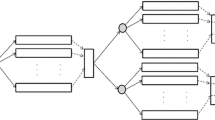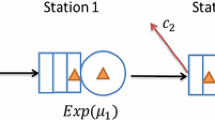Abstract
We propose an admission and routing control policy for a network of service facilities in a stochastic setting in order to maximize a long run average reward. Queueing and reneging before entering the network is allowed; we introduce orbiting as an approximation to the queueing. Once a customer has entered the network, it incurs no more waiting. Our control policy is easy to implement and we prove that it performs well in steady state as long as the capacity request sizes are relatively small compared to the capacity of the service facilities. The policy is a target tracking policy: a linear program provides a target operating point and an exponential penalty function is used to translate the optimal deterministic point into a feasible admission and routing policy. This translation essentially transforms the admission and routing control problem into a problem of load balancing via the construction of fictitious systems. Simulation studies are included to illustrate that our policy also performs well when request sizes are moderate or large with respect to the capacity.
Similar content being viewed by others
References
J. Aspnes, Y. Azar, A. Fiat, S. Plotkin and O. Waarts, Online routing of virtual circuits with applications to load balancing and machine scheduling, J. ACM 44(3) (1997)486–504.
B. Awerbuch, Y. Azar, S. Plotkin and O. Waarts, Competitive routing of virtual circuits with unknown duration, J. Comput. System Sci. 62(3) (2001)385–397.
Y. Azar, B. Kalyanasundaram, S. Plotkin, K.R. Pruhs and O. Waarts, Online load balancing of temporary tasks, J. Algorithms 22(1) (1997)93–110.
N. Bauerle, Asymptotic optimality of tracking policies in stochastic networks, Ann. Appl. Probab. 10(4) (2000)1065–1083.
P.P. Belobaba, Allocation of a probabilistic decision model to airline seat inventory control, Oper. Res. 37 (1989)183–197.
D. Bertsimas, I. Paschalidis and J. Tsitsiklis, Optimization of multiclass queueing networks: Polyhedral and nonlinear characterizations of achievable performance, Ann. Appl. Probab. 4(1)43–75.
D. Bienstock, Potential function methods for approximately solving linear programs: Theory and practice, in: CORE Lecture Series (2001) to appear.
G.R. Bitran and S.M. Gilbert, Managing hotel reservations with uncertain arrivals, Oper. Res. 37 (1996)35–49.
D. Down and S.P. Meyn, Piecewise linear test functions for stability and instability of queueing networks, Queueing Systems 27 (1998)205–226.
D. Gamarnik, D. Bertsimas and J.N. Tsitsiklis, Performance of multiclass Markovian queueing networks via piecewise linear Lyapunov functions, Ann. Appl. Probab., to appear.
N. Garg and J. Kneman, Faster and simpler algorithms for multicommodity flows and other fractional packing problems, in: Proc. of the 39th FOCS (1998) pp.300–309.
R.J. Gibbens and F.P. Kelly, Network programming methods for loss networks, IEEE J. Selected Areas Commun. 13 (1995)1189–1198.
M.D. Grigoriadis and L.G. Khachiyan, Fast approximation schemes for convex programs with many blocks and coupling constraints, SIAM J. Optim. 4 (1994)86–107.
S. Halfin and W. Whitt, Heavy traffic limits for queues with many exponential servers, Oper. Res. 29 (1981)567–588.
G. Iyengar and K. Sigman, Exponential penalty function control of loss queues, Ann. Appl. Probab., to appear.
A. Kamath, O. Palmon and S. Plotkin, Routing and admission control in general topology networks with Poisson arrivals, J. Algorithms 27(2) (1998)236–258.
F.P. Kelly, Loss networks, Ann. Appl. Probab. 1(3) (1991)319–378.
P.B. Key, Optimal control and trunk reservation in loss networks, Probab. Engrg. Inform. Sci. 4 (1990) 203–242.
A.J. Kleywegt and J.D. Papastavrou, The dynamic and stochastic knapsack problem, Oper. Res. 46(1) (1998)17–35.
S. Kumar and P.R. Kumar, Performance bounds for queueing networks and scheduling policies, IEEE Trans. Automat. Control 39(8) (1994)1600–1611.
S. Ladany, Bayesian dynamic operating rules for optimal hotel reservation, Oper. Res. B 21 (1977) 165–176.
C. Maglaras, Dynamic scheduling in multiclass queueing networks: Stability under discrete-review policies, Queueing Systems 31 (1999)171–206.
C. Maglaras, Discrete review policies for scheduling stochastic networks: Trajectory tracking and fluid scale asymptotic optimality, Ann. Appl. Probab. 10(3) (2000)897–929.
J.I. McGill and G.J. van Ryzin, Revenue management: research overview and prospects, Transport. Sci. 33(2) (1999)233–256.
D. Mitra, J.A. Morrison and K.G. Ramakrishan, ATMnetwork design: a multirate loss network framework, IEEE/ACM Trans. Networking 4 (1996)531–543.
C. Papadimitriou and J. Tsitsiklis, The complexity of optimal queueing network control, Math. Oper. Res. 24 (1999)293–305.
T.J. Ott and K.R. Krishan, Separable routing: A scheme for state dependent routing of circuit switched telephone networks, Ann. Oper. Res. 35 (1992)43–68.
S.A. Plotkin, D.B. Shmoys and E. Tardos, Fast approximation algorithms for fractional packing and covering problems, in: 32nd Annual Symposium on Foundations of Computer Science, San Juan, PR (1991) (IEEE Comput. Soc. Press, Los Alamitos, CA,1991) pp.495–504.
K.W. Ross, Multiservice Loss Models for Broadband Communication Networks (Springer, Berlin, 1995).
K.W. Ross and D.H.K. Tsang, The stochastic knapsack problem, IEEE Trans. Commun. 37 (1989) 740–747.
K.W. Ross and D.D. Yao, Monotonicity properties for the stochastic knapsack, IEEE Trans. Inform. Theory 36 (1990)1173–1179.
S. Savin, M. Cohen, N. Gans and Z. Katalan, Capacity management in rental businesses with heterogeneous customer bases, Technical Report, Wharton School, University of Pennsilvania (2000).
F. Shahrokhi and D.W. Matula, The maximum concurrent flow problem, J. Assoc. Comput. Mach. 37 (1990)318–334.
S. Shakkottai and A.L. Stolyar, Scheduling for multiple flows sharing a time-varying channel: The exponential rule, in: Translations of the AMS, a Volume in Memory of F. Karpelevich (Amer. Math. Soc., Providence, RI,2002 to appear.
S. Shakkottai, R. Srikant and A.L. Stolyar, Pathwise optimality of the exponential scheduling rule for wireless channels, Working paper (2001).
Y.C. Teh, Dynamic scheduling for queueing networks derived from discrete review policies, Fields Institute Communications.
F.E. Williams, Decision theory and the innkeeper: an approach for setting hotel reservation policy, Interfaces 7 (1977)18–30.
N. Young, Randomized rounding without solving the linear program, in: Proc. of the 6th ACM-SIAM Symposium on Discrete Algorithms (1995) pp.170–178.
T. Yang and J.G.C. Templeton, A survey on retrial queues, Queueing Systems 2 (1987)201–233.
Author information
Authors and Affiliations
Rights and permissions
About this article
Cite this article
Cosyn, J., Sigman, K. Stochastic Networks: Admission and Routing Using Penalty Functions. Queueing Systems 48, 237–262 (2004). https://doi.org/10.1023/B:QUES.0000046578.47761.4c
Issue Date:
DOI: https://doi.org/10.1023/B:QUES.0000046578.47761.4c




